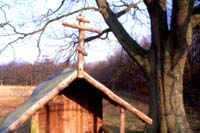Shropshire’s Orthodox monastery
 |
 |
 |
The little hand-built chapel of St Anthony and St Cuthbert |
In the 1990s a Greek Orthodox monk and icon-painter came to Shropshire from Mt Athos. Originally from New Zealand, Aidan was given a farmhouse and small-holding of 20 acres near Stiperstone nature reserve where legend says the Bishop of London took refuge from the Anglo-Saxons in the 5th century.
He decided to create an Orthodox hermitage. Soon the barn became a chapel and the stone pigsties humble cells for visitors wanting to go into retreat. Before long other monks joined him to form the Monastery of St Cuthbert and St Anthony.
Within two years more than 4,000 native trees were planted. The landscape was of special ecological value because of its variety of land types – it is a valley with established native trees, wetland, meadows and woodlands.
Sacred Land helped the monastery to create a series of new sacred woodlands within which lie small wooden chapels for meditation, advising the monks how to identify the right trees and where to go for funding at a national and county level.
They were helped to bring young people from Orthodox traditions all over Europe to work on the land and plant trees.
The monastery is now developing a wildflower meadow that will be made simply by turning over the land and allowing the seeds that have lain dormant for years to achieve their flowering potential. All this activity is fully in keeping with Orthodox beliefs that the human role in God's creation is to make it more beautiful and help it reach its full potential.
 |
| The monastery has become a pilgrimage centre for Orthodox visitors from all around the world. |
|
 |
 |
The remote site has become a pilgrimage centre for Orthodox visitors from all around the world.
|

